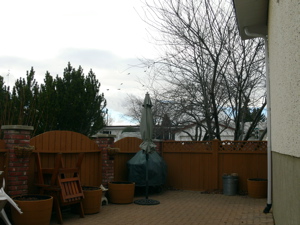 |
|
||||||||||||||
| Links to Notebook Pages: |
Monday November 13, 2006 7:00 am Lethbridge Sunrise 7:40 Sunset 17:52 Hours of daylight: 9:12
A. Morning Musings
7:00 am It is +4 C at the moment with a high of +8 C forecast. There is a high wind warning for this afternoon with gust between 70 and 90 kmh.
I am up a bit later this morning, but am feeling refreshed and ready for the day.
Model trains: I have now assembled 2 of the kits for the 100 ton quad hoppers. Hopefully I will complete another 2 today. Now that I have the mainline track all nailed down as well as the spur tracks for Black Diamond, Distillery Row and The Channon, I want to try running some prototypical trains and get a feel for the operating characteristics of the layout.
Literature: I finally began reading "Empire of the Sun" last evening. Now to get back into that routine of regular reading.
B. Plan
Immediate Health Walk & exercise 2 hr Model Trains Continue assembly of 6 quad hopper cars 1 hr Mathematics Read "Fearless Symmetry" chap 8: Galois groups 1 hr History Continue reading & making notes for "Citizens" 2 hr GO Begin playing GO++ on a 9x9 board 2 hr Literature Continue reading "Empire of the Sun" by J. G. Ballard 2 hr Later Chores Investigate water softeners for home Technology Read manual for cell phone Make notes for chap. 4 of "Switching to the Mac" Begin reading "iPhoto" digital photography - learn about using the various manual settings
Philosophy Read "The Art of Living" by Epictetus Mathematics Larson "Calculus" Read "The Computational Beauty of Nature" Chap 3 Gardner "The Colossal Book of Short Puzzles" History Watson "Ideas" Model Trains Build oil refinery diorama: add ground cover Assemble second oil platform kit Assembly of CN 5930, an SD40-2 with a NAFTA logo Puzzles The Orange Puzzle Cube: puzzle #9
C. Actual/Notes
1:10 PM
Notes for Learning to play the strategy game of GO.
1:20 PM I am motivated by the web sites that I saw yesterday to begin making some notes on my - beginning now - efforts to Learn the strategy game of GO.
My initial thoughts are to find a balance between reading, working on problems, and playing games (both against the computer and against humans on the Internet). And in addition to that balance, coming up with a good system for keeping notes.
My initial note-making will continue to follow the two-color box system of tan for my reflective comments and green for actual content.
I will begin by having a close look at the sensei web site that I found yesterday: http://senseis.xmp.net/
This has a link to a Beginner Study Section: http://senseis.xmp.net/?BeginnerStudySection .
Now to fill my coffee cup and begin.
The Beginner Study Section contains 15 sections ( 0 - 14).
Section 1 provides a clear introduction to the rules of the game. I am familiar with all of this material, but a few key terms deserve repeating: point, empty point, liberty, and ko. It is important to Learn the jargon of the game so that one can read books on GO as well as being able to communicate with other players. The only term that I am a little bit fuzzy on is that of a "ko". I definitely need to do more reading about "ko".
Section 2 discusses the basic idea of territory and scoring the end game. I feel that I have a good understanding of this.
Section 3 is about "life and death" and the concept of "two eyes". I understand the concept but the description then proceeds to show all of the possible configurations for the smallest number of live groups in a corner (6 stones) - four distinct patterns, the smallest number of live groups along the side (8 stones) - four distinct patterns, and the smallest number of live groups in the center (10 stones) - four distinct patterns. I will come back to this tomorrow. All of these patterns should be memorized so they are automatic perceptual patterns.
Now I will start up GO++ and play 3 games of 9x9 with a playing level of 2 (second weakest). I play black and give a komi to white of 6.5 points.
I lose the first game by 1.5 points. This was a close game and fun to play.
I lose the second game by 27.5 points. Clearly this was a poorly played game.
I lose the third game by 43.5 points. This was closer than the final score would indicate. White made a major incursion into my territory at the end and I was unable to stop it.
These games were a good wake-up call. I am in genuine need of improvement!
So far I have done a little reading from a web site and played 3 9x9 games against software. Now to have a look at a book of GO problems.
Graded GO problems for Beginners Volume One Introductory Problems (30-kyu to 25 kyu).
Section 1 How to capture stones. Problems 1 - 14. All trivially easy.
Section 2 How to save endangered stones. Problems 15 - 22. All trivial.
Section 3 Recognizing atari. Problems 23 - 30. All trivial.
Section 4 Connecting and separating stones. Problems 31 - 34. I missed the solution to #34.
Section 5 Ko Problems 35 - 38. I solved them, but I had to think. They were not (yet) trivial.
SUMMARY of the session: I engaged in 3 different types of activities - reading about the game, playing 3 9x9 games against software (I lost all 3 games), and solving 38 introductory problems (only 1 gave me any difficulty). I enjoyed the variety of activities but was disappointed with my game playing of the 9x9 games. I also need to learn how to use the GO++ software to replay and analyze a previously played game.
I will try this now and see if it is straight forward. It is. Good. I went over the first game that I played and compared my moves with those suggested by the software. Overall, I didn't play that poor a game. I must add this activity as a fourth component of my sessions.
3:30 PM My first GO Learning session lasted for 2 hours, but the time simply flew by. An encouraging beginning.
D. Reflection


